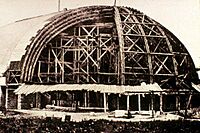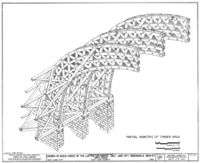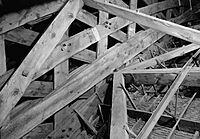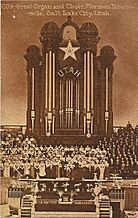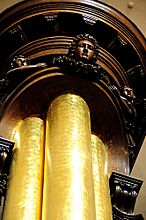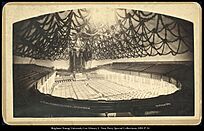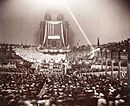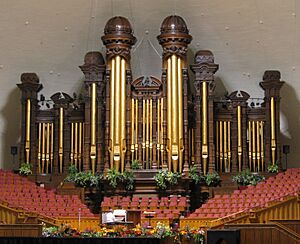Salt Lake Tabernacle facts for kids
|
Mormon Tabernacle
|
|
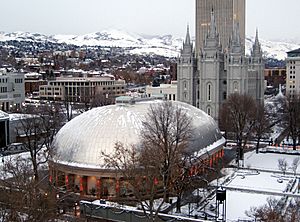
The exterior of the Tabernacle in December 2008
|
|
| Location | 50 W. North Temple Salt Lake City, Utah |
|---|---|
| Coordinates | 40°46′13.5″N 111°53′35.3″W / 40.770417°N 111.893139°W |
| Public transit | Temple Square Trax Station |
| Owner | The Church of Jesus Christ of Latter-day Saints |
| Type | Auditorium |
| Seating type | Reserved by Section |
| Capacity | 3,500 (after 2007 renovation) |
| Construction | |
| Broke ground | July 26, 1864 |
| Opened | October 6, 1867 (First General Conference held) October 9, 1875 (building dedication) |
| Architect | Henry Grow Truman O. Angell (1870 gallery addition) with contributions from William Folsom and Brigham Young |
| Website | |
| Salt Lake Tabernacle | |
The Salt Lake Tabernacle is a famous building located on Temple Square in Salt Lake City, Utah. It was built between 1863 and 1875 for large meetings of The Church of Jesus Christ of Latter-day Saints. For many years, it hosted the church's big semi-annual conferences. These meetings moved to the larger LDS Conference Center in 2000.
Today, the Tabernacle is a historic landmark. It is still used for extra crowds during conferences. It is also famous for its amazing sound quality and its huge pipe organ. The well-known Tabernacle Choir has performed there for over 100 years.
Contents
Building the Tabernacle
Construction of the Tabernacle began in 1864 and finished in 1867. It was built near the Salt Lake Temple. In 1892, it was the largest meeting hall in the United States. The building has a sandstone base. Its unique dome-shaped roof is supported by 44 sandstone pillars. Before a big update in 2007, the building could hold about 7,000 people. This included the choir area and the balcony.
How the Roof Was Built
Henry Grow, an engineer, led the first part of the Tabernacle's construction. The most amazing part was the domed roof. Brigham Young, who was the church president, wanted a roof with no inside pillars. This way, everyone could see the stage clearly.
Grow designed the roof to be 150 feet wide, 250 feet long, and 80 feet high. Many people thought the roof would fall when the temporary supports were removed. But Grow built it using a special "lattice truss" system. This system used timbers held together with wooden pegs. Green rawhide was wrapped around the timbers. As the rawhide dried, it tightened, making the roof even stronger. The roof was covered with shingles, which were later replaced with aluminum in 1947.
Inside the Tabernacle
The first benches and balcony supports were made from local "white pine" trees. The pioneers painted them to look like oak and marble. This was because they wanted to "give their best to the Lord." During the 2007 renovation, the old benches were replaced with new oak ones. This made more legroom but reduced the seating capacity by 1,000 seats.
The famous Salt Lake Tabernacle organ is at the west end, above the choir seats. It is a main feature of the building. The first organ was built in 1867 with 700 pipes. Over time, it has been rebuilt several times. Now, it has 11,623 pipes, making it one of the largest pipe organs in the world. The current organ was finished in 1948 and updated in 1989.
Building Design and Art
The Tabernacle was an amazing building for its time. A writer for Scientific American even wrote about how hard it was to build such a large roof. Some people joked that it looked like a "soup kettle" or a "holy turtle." But famous architect Frank Lloyd Wright called it "one of the architectural masterpieces of the country and perhaps the world."
Art and Decorations Inside
For many years, the Tabernacle had different artworks on its walls. There was a painting showing Joseph Smith receiving the Gold plates. A portrait of Joseph Smith also hung near the organ. In 1875, a fountain was placed inside, representing "living water." A statue of an angel with a trumpet was also added near the organ pipes.
The building also had many decorations. These included a blue banner with a gold beehive, a star with the word Utah, and American flags. Some flags were very large, measuring 75 feet by 160 feet! There were also bunting, garland, festoons, and flowers.
What the Tabernacle Is Used For
The Tabernacle was the main place for the church's semi-annual general conferences for 132 years. As the church grew, the conferences moved to the new and larger Conference Center in 2000. The Tabernacle is still used for extra attendees during these conferences.
The Tabernacle is the home of The Tabernacle Choir at Temple Square. It was also the home of the Utah Symphony Orchestra before Abravanel Hall was built. It is the historic place where the famous radio and TV show Music and the Spoken Word is broadcast.
Amazing Sound Quality
The Tabernacle was built before electronic sound systems existed. It was designed to have amazing acoustic qualities. This means everyone in the large building could hear sermons clearly. The roof was shaped like a three-dimensional ellipse. The speaker's pulpit was placed at one special point of this ellipse. This design helps sound from the pulpit travel and be heard clearly at the other end of the building.
Years after it was built, Truman O. Angell helped make the sound even better. He added the balcony in 1870, which solved any remaining sound issues. The building is known worldwide for its nearly perfect acoustics. You can even hear a pin drop from one side of the building to the other, over 250 feet away!
Updates and Renovations
The Tabernacle was closed from January 2005 to March 2007 for major renovations. These updates included making the building stronger against earthquakes. The visible organ pipes were given new gold leafing. The ceiling was fixed and repainted. New dressing rooms and a music library were built for the choir. Three recording studios were added under the main floor. The stage area was also updated. All the plumbing was replaced.
The building reopened in March 2007 and was rededicated on March 31, 2007. An opening concert with the Tabernacle Choir was held in April 2007. As part of the renovation, all 44 pillars supporting the roof were strengthened with steel bars and concrete.
Famous Visitors
Many important people have spoken from the Tabernacle pulpit. Twelve presidents of the United States have visited, including Theodore Roosevelt, Franklin D. Roosevelt, and John F. Kennedy.
Other famous speakers include Susan B. Anthony (a leader for women's rights), Charles Lindbergh (the first person to fly solo across the Atlantic), and Helen Keller (a famous author and activist). Susan B. Anthony praised the Tabernacle, calling it "the most magnificent gathering I ever saw."
In 1980, actor James Stewart even conducted the Tabernacle Choir there for a TV special called Mr. Krueger's Christmas.
Visiting the Tabernacle
At first, tourists were not encouraged to visit the Tabernacle. It was seen as a very sacred place. However, tours became more common by 1900.
Today, anyone can take a tour of the Tabernacle. Missionaries from The Church of Jesus Christ of Latter-day Saints often lead these tours. They like to show off the amazing acoustics by dropping a pin on the pulpit or tearing a newspaper. The sound can be heard throughout the entire building!
See also
 In Spanish: Tabernáculo de Salt Lake City para niños
In Spanish: Tabernáculo de Salt Lake City para niños
- List of concert halls
- Salt Lake Assembly Hall
- Salt Lake Temple
- List of pipe organs



